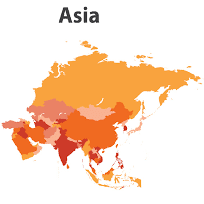Fidelity Asian Values plc (LON:FAS) is the topic of conversation when Hardman and Co’s Analyst Mark Thomas caught up with DirectorsTalk for an exclusive interview.
Q1: You called your recent report on Fidelity Asian Values ‘India: adding spice to the mix’. What can you tell us about it?
A1: India accounts for 23% of FAV’s portfolio and the top two overweight positions, both of which are Financials.
In this note, we examine some of the key macro attractions of that market, which help generate favourable tailwinds for investment. These include economic growth, socio-demographic changes, digitalisation and deregulation. We also use the two overweight, very different Indian case studies, to illustrate FAV’s investment approach and how it adds value in the process. In six months, the Trust’s NAV has risen to our previous July 2023 year-end estimate.
We have now increased our forecast by 8%, reflecting performance to date, stock selection and the regional outlook.
Q2: So, why invest in India?
A2: Before I go into that, just a reminder that FAS is driven by stock selection, but favourable headwinds help investment and sentiment.
The IMF’s January World Economic Outlook update once again highlighted the superior economic prospects (and lower downside revisions) of India over both advanced economies and critically ca.1.5x most emerging markets. This superior growth is a long-term feature driven by the expectation for the middle-class proportion of spending to double in the next 25 years, and, combined with accelerating rate of urbanisation, this will see significant domestic demand changes and opportunities.
Additionally, there is a rapid smartphone and digital transaction adoption with India now third globally for unicorns. To put unicorns into perspective, India’s performance is around twice the number of the UK and four times the number of Germany or France. On top of this, there is major reform of the business environment with government support, including government’s production-linked incentive or PLI schemes, lower taxes and focus on helping infrastructure. India moved from 132 in 2013 to 63 in 2020 in the World Bank’s ease of doing business index and recently, has seen more appetite for free trade agreements.
Q3: You included a couple of major investments as case studies, what did you learn from that?
A3: We looked at their two largest holdings: Shriram Finance Ltd – formerly holding in Shriram City Union Finance Ltd a niche lender requiring specific skills built over many decades; and Axis bank the third-largest private-sector bank in India.
The key issues are that they have high returns, good growth, good ESG credentials. As a reminder, Fidelity Asian invests in companies not stocks.
Q4: You have touched on some long-term factors there , what can you tell us about the near term?
A4: Half of NAV is in companies with market caps of under £1bn, so market appetite for small caps can be important. This was a headwind for much of 2016-21, as market appetite was for large-cap, growth companies – but Fidelity Asian Values still outperformed.
One short-term theme we have identified is that, more recently, appetite has turned in their favour, and this could now be a following wind. The manager sees it as the start of a trend, given the relative valuation, while we see significant opportunities in that space.
A second theme is that, whilst Chinese growth may be slower than in the past, it is still expected by the IMF to be many multiples of advanced economies in 2023, and that’s before any further stimulus packages. The manager comments that, even in the property sector, detailed analysis can identify mis-priced opportunities. The volatility, both up and down, around regulation and state intervention, has been very evident in recent weeks.
It is worth remembering that FAS is all about stock selection, not sector allocation. The past six months have seen a material rise in their benchmark and additionally, significant outperformance against this by the Trust driven by stock selection. As a consequence, it achieved our previous July 2023 year-end forecast.
Reflecting this performance and the recent economic upgrades, we increased our 2023E NAV by 8%, with a carry-forward effect into 2024. Given the higher capital growth we now expect, we also now assume a stable dividend.
Q5: What about the risks?
A5: Sentiment risk is always an issue, and the manager highlights the “unknown unknowns”. The fund’s performance is driven by stock selection, and that should never be overlooked.
It is not a complicated story. It invests in good businesses – not stocks, but businesses. It backs people in whose competency and honesty it trusts, and buys at prices with a margin of safety. It does this again and again, and it doesn’t get carried away and doesn’t go to extremes, it just repeats the same behaviour, again and again. It sounds quite boring, but, by maintaining this discipline, with the Fidelity analyst team generating great investment ideas, and with the through-cycle support of the board, they have delivered long-term outperformance.
What we’ve done in this note is highlight that this approach is being undertaken in very appealing markets that give favourable tailwinds, a potential double whammy, if you like.


